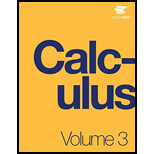
Evaluate the iterated
82.
Want to see the full answer?
Check out a sample textbook solution
Chapter 5 Solutions
Calculus Volume 3
Additional Math Textbook Solutions
Calculus: Early Transcendentals (2nd Edition)
Elementary Statistics (13th Edition)
A First Course in Probability (10th Edition)
Elementary Statistics: Picturing the World (7th Edition)
A Problem Solving Approach To Mathematics For Elementary School Teachers (13th Edition)
University Calculus: Early Transcendentals (4th Edition)
- The analysis of results from a leaf transmutation experiment (turning a leaf into a petal) is summarized by the type of transformation completed: A naturalist randomly selects three leaves from this set without replacement. Total Textural Transformation Yes No Total Yes 243 26 269 Total Color Transformation No 13 18 31 Total 256 44 300 Let X represent the number of leaves that have undergone both transformations. The appropriate probability distribution of X is a distribution. The parameters are population size N = size n = number of events K = and sample The probability that at least one leaf has undergone both transformations is probability to four decimal places.) X has a N = K= n = The requested probability is distribution. (Round thearrow_forwardThe life time of a certain battery is modeled with the Weibull distribution with shape parameter ẞ=2 and scale parameter 8-10 hours. Determine the mean time until failure of batteries. (Round the answer to one decimal place.) hoursarrow_forwardNeed help pleasearrow_forward
- Consider the probability distribution below. 0 1 3 f(x) 0.3 0.3 0.4 E(X)=1.5. The variance of XV (X) equals 1.65 ○ 1.28 1.56 2.33arrow_forward7. [10] Suppose that Xi, i = 1,..., 5, are independent normal random variables, where X1, X2 and X3 have the same distribution N(1, 2) and X4 and X5 have the same distribution N(-1, 1). Let (a) Find V(X5 - X3). 1 = √(x1 + x2) — — (Xx3 + x4 + X5). (b) Find the distribution of Y. (c) Find Cov(X2 - X1, Y). -arrow_forward1. [10] Suppose that X ~N(-2, 4). Let Y = 3X-1. (a) Find the distribution of Y. Show your work. (b) Find P(-8< Y < 15) by using the CDF, (2), of the standard normal distribu- tion. (c) Find the 0.05th right-tail percentage point (i.e., the 0.95th quantile) of the distri- bution of Y.arrow_forward
- 6. [10] Let X, Y and Z be random variables. Suppose that E(X) = E(Y) = 1, E(Z) = 2, V(X) = 1, V(Y) = V(Z) = 4, Cov(X,Y) = -1, Cov(X, Z) = 0.5, and Cov(Y, Z) = -2. 2 (a) Find V(XY+2Z). (b) Find Cov(-x+2Y+Z, -Y-2Z).arrow_forwardConsider the probability distribution below. 10 20 30 40 f(x) 0.3 0.4 0.2 0.1 The expected value of X equals 100 ○ 25 ○ 18 ○ 21arrow_forwardThe analysis of results from a leaf transmutation experiment (turning a leaf into a petal) is summarized by the type of transformation completed: A naturalist randomly selects three leaves from this set without replacement. Total Textural Transformation Yes No Total Yes 243 26 269 Total Color Transformation No 13 18 31 Total 256 44 300 Let X represent the number of leaves that have undergone both transformations. The appropriate probability distribution of X is a distribution. The parameters are population size N = size n = number of events K = and sample The probability that at least one leaf has undergone both transformations is probability to four decimal places.) X has a N = K= n = The requested probability is distribution. (Round thearrow_forward
- The thickness of a flange on an aircraft component is uniformly distributed between 0.95 and 1.05 millimeters. Determine the mean of flange thickness. millimeters (Two decimal places.)arrow_forwardThe following table is an output from a statistical software package. The assumed standard deviation = 1.5 Variable X N 9 Mean 29.542 Σ-1 - Sum of Squares (SS): SS = Σ₁ (x − x) ² SE Mean ? StDev Variance Sum of Squares 1.218 ? ? Fill the missing information. Round answers to 3 decimal places. SE Mean = Variance = Sum of Squares =arrow_forwardFor the random variable x = 1,2,3,4, the probability mass function is f(x) = x 10 Determine the following probabilities. Round answers to one decimal place. (a) P(X = 2) = (b) P(X ≤ 2) = (c) P(X > 4) = (d) P (0 < x < 3) =arrow_forward
 Discrete Mathematics and Its Applications ( 8th I...MathISBN:9781259676512Author:Kenneth H RosenPublisher:McGraw-Hill Education
Discrete Mathematics and Its Applications ( 8th I...MathISBN:9781259676512Author:Kenneth H RosenPublisher:McGraw-Hill Education Mathematics for Elementary Teachers with Activiti...MathISBN:9780134392790Author:Beckmann, SybillaPublisher:PEARSON
Mathematics for Elementary Teachers with Activiti...MathISBN:9780134392790Author:Beckmann, SybillaPublisher:PEARSON
 Thinking Mathematically (7th Edition)MathISBN:9780134683713Author:Robert F. BlitzerPublisher:PEARSON
Thinking Mathematically (7th Edition)MathISBN:9780134683713Author:Robert F. BlitzerPublisher:PEARSON Discrete Mathematics With ApplicationsMathISBN:9781337694193Author:EPP, Susanna S.Publisher:Cengage Learning,
Discrete Mathematics With ApplicationsMathISBN:9781337694193Author:EPP, Susanna S.Publisher:Cengage Learning, Pathways To Math Literacy (looseleaf)MathISBN:9781259985607Author:David Sobecki Professor, Brian A. MercerPublisher:McGraw-Hill Education
Pathways To Math Literacy (looseleaf)MathISBN:9781259985607Author:David Sobecki Professor, Brian A. MercerPublisher:McGraw-Hill Education





